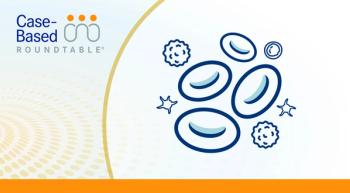
Germline Predisposition Explains MDS Etiology in Some Pediatric Patients
Predisposition to forms of myelodysplastic syndrome (MDS) and acute myeloid leukemia (AML) in pediatric patients can be caused by either classical inherited bone marrow failure syndromes or recently discovered genetic predisposition syndrome with autosomal dominant inheritance, Marcin Wlodarski, MD, explained.
Marcin Wlodarski, MD
Predisposition to forms of myelodysplastic syndrome (MDS) and acute myeloid leukemia (AML) in pediatric patients can be caused by either classical inherited bone marrow failure syndromes or recently discovered genetic predisposition syndrome with autosomal dominant inheritance. Marcin Wlodarski, MD, explained inherited predisposition to pediatric MDS in a presentation during the 2018 SOHO Annual Meeting.
There are several differences between MDS in children and in adults. In children, it is a rare disease, and most pediatric cases present with pancytopenia. Extremely rare cases of MDS in children are MDS with single cell dysplasia, ring sideroblasts, or 5q-syndrome. Pediatric MDS often arises from inherited disease, and prognostic variable in adult MDS are not applicable in children, explained Wlodarski, assistant member of St. Jude Children’s Research Hospital.
“While the clinical presentation can be very diverse and involve neurology, endocrinology, immunology, or syndromic presentation, the common hematological denominators are cytopenia and MDS/AML with monosomy 7 or partial 7q deletion (del7q),” noted Wlodarski.
Historically, the bone marrow failure syndromes such as Fanconi anemia or congenital neutropenia have been attributed to inherited forms of MDS and AML. In 2004, the CEBPAmutation was discovered to cause non-syndromic familial AML, marking a new era of discovery for these patients, said Wlodarski. Since then, multiple germline mutations have been discovered to link to MDS/AML predisposition, includingCATA2, RUNX1, ETV6, ANKRD26, DDX41, SAMD9, andSAMD9L.
"Most of these syndromes are associated with congenital anomalies and nonhematologic features. Also, the risk for solid tumors is increased in most of them, and surface somatic mutations can occur," said Wlodarski.
In 2017, the World Health Organization (WHO) published guidelines of inherited myeloid neoplasms in children, focusing on syndromes associated withGATA2andSAMD6/SAMD9Lmutations.
WHO categorizes patients into 3 major subgroups: patients with germline predisposition without a preexisting disorder or organ dysfunction, patients with germline predisposition and preexisting platelet disorders, and patients with germline predisposition and other organ dysfunction, explained Wlodarski.
The first subgroup includes patients with AML with germlineCEBPAmutations and myeloid neoplasms with germlineDDX41mutations. The second subgroup includes patients with myeloid neoplasms with germline RUNX1, ANKRD26,andETV6mutations. Lastly, the third subgroup includes patients with myeloid neoplasms with germline GATA2mutations, myeloid neoplasms that are associated with bone marrow failure syndromes, telomere biology disorders, juvenile myelomonocytic leukemia associated with neurofibromatosis, Noonan syndrome or Noonan syndrome-like disorders, as well as Down syndrome.
GATA2deficiency is found is 7% of all pediatric MDS, and 15% of MDS with excess blasts. Of these patients, 70% have monosomy 7.
"GATA2deficiency is the most common genetic predisposition to pediatric MDS, and is associated with monosomy 7 and immunodeficiency," explained Wlodarski. "SAMD9/SAMD9Lgenes [are] new players in MDS associated with monosomy 7 and corrective UPD7q."
Nonhematological features ofGATA2include immunodeficiency, lymphedema or hydrocele, urinary tract abnormalities, behavioral problems such as attention-deficit/hyperactivity disorderor Autism spectrum disorder, and congenital deafness, according to Wlodarski. Low B cells are the most consistent feature, though, which encompass natural killer cells, dendritic cells, monocytopenia, low CDK4/8 ratio, viral infections like warts, or mycobacterial infections.
One of the newer discoveries isSAMD9Lgermline disease. The median age of diagnosis is 2.1 years, and prior cytopenias and recurrent infections are present in some patients, said Wlodarski. Patients with SAMD9Lgermline disease have monosomy 7 of del7q karyotypes, corrective UPD7q, and reduced penetrance. Additionally, patients have no dysmorphisms, and neurology is normal.
Currently, clinicians utilize hematopoietic stem cell transplantation (HSCT) as a curative approach. This is the feasible curative approach in most children, Wlodarski said. He added that HSCT should be performed before manifestation of life-threatening complications, as well as excessive blasts for optimal results. Several patients with high-risk monosomy 7 karyotype who received HSCT during childhood have been observed to have long-lasting remission.
The discovery of these germline mutations opens a new door for investigation. Soon, pediatric patients with this rare disease may have multiple options for treatment, he added.
"There are ongoing discoveries of novel bone marrow failure syndromes and MDS on the way," concluded Wlodarski.
Reference:
Wlodarski M, Pastor V, Sahoo S, et al. Inherited predisposition and pediatric MDS. In: Proceedings from the 2018 SOHO Annual Meeting; September 13-16, 2018; Houston, Texas. Abstract WE-S15-MDS-030.









































